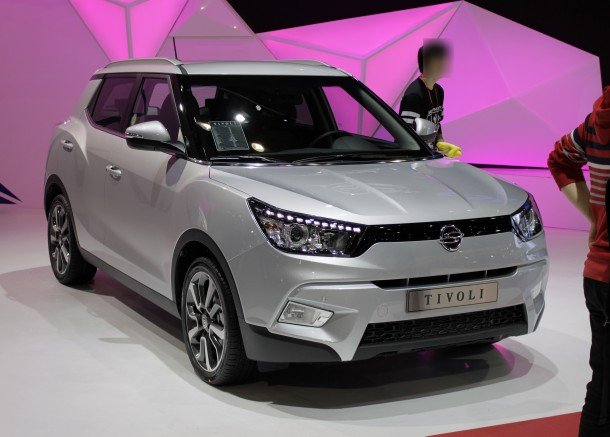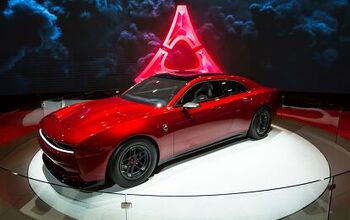Ssangyong Hopes to Inject More Mediocre Crossovers Into the U.S. Market

America’s unhealthy obsession with crossover vehicles has led to Ssangyong Motor Company’s decision to enter the U.S. market by 2020.
The Korean manufacturer has hinted at, and even announced, plans to come to America before with no resulting action. This time, things seem a little more realistic, with Automotive News reporting that the company is designating two small SUVs for the United States — the Tivoli and Korando — and giving itself a slightly longer timeline.
Ssangyong’s Tivoli competes with the Kia Soul in Europe and has received moderate praise and decent success. The Korando is slightly larger and will theoretically be going up against the Honda CR-V or, more realistically, Nissan Rogue in the American market. The Tivoli will be updated while the Korando will be an entirely new version of the old vehicle. While these Korean compact crossovers have been praised for affordability and function in Europe, neither will be winning awards for refinement or style in their current forms.
Ssangyong CEO Choi Johng-sik explained the plan to Automotive News at the Paris Auto Show. “America is very, very competitive, so we need to build a good brand,” he said. “That’s why we’re now preparing completely new products.”
Selling vehicles primarily equipped with diesel motors in Europe, Ssangyong is also developing two turbocharged four-cylinder gasoline engines for use in their U.S. vehicles. One will be a 1.5-liter engine making 162 horses, the other a 2.0-liter unit rated at 220 hp.
With small SUV and crossover sales more popular than ever, it certainly seems like the right time to get in on the action. But Ssangyong has a long way to go before that happens. The company still has to produce the new cars, pass emissions requirements, ensure they meet U.S. safety regulations, sort out distribution, and come up with a snazzy U.S.-based marketing strategy. That’s a lot to do for a company that has not produced a profit since 2001.
I guess we’ll see what happens.
[Image: Minseong Kim/ Wikimedia Commons ( CC BY-SA 4.0)]

A staunch consumer advocate tracking industry trends and regulation. Before joining TTAC, Matt spent a decade working for marketing and research firms based in NYC. Clients included several of the world’s largest automakers, global tire brands, and aftermarket part suppliers. Dissatisfied with the corporate world and resentful of having to wear suits everyday, he pivoted to writing about cars. Since then, that man has become an ardent supporter of the right-to-repair movement, been interviewed on the auto industry by national radio broadcasts, driven more rental cars than anyone ever should, participated in amateur rallying events, and received the requisite minimum training as sanctioned by the SCCA. Handy with a wrench, Matt grew up surrounded by Detroit auto workers and managed to get a pizza delivery job before he was legally eligible. He later found himself driving box trucks through Manhattan, guaranteeing future sympathy for actual truckers. He continues to conduct research pertaining to the automotive sector as an independent contractor and has since moved back to his native Michigan, closer to where the cars are born. A contrarian, Matt claims to prefer understeer — stating that front and all-wheel drive vehicles cater best to his driving style.
More by Matt Posky
Latest Car Reviews
Read moreLatest Product Reviews
Read moreRecent Comments
- El scotto UH, more parking and a building that was designed for CAT 5 cable at the new place?
- Ajla Maybe drag radials? 🤔
- FreedMike Apparently this car, which doesn't comply to U.S. regs, is in Nogales, Mexico. What could possibly go wrong with this transaction?
- El scotto Under NAFTA II or the USMCA basically the US and Canada do all the designing, planning, and high tech work and high skilled work. Mexico does all the medium-skilled work.Your favorite vehicle that has an Assembled in Mexico label may actually cross the border several times. High tech stuff is installed in the US, medium tech stuff gets done in Mexico, then the vehicle goes back across the border for more high tech stuff the back to Mexico for some nuts n bolts stuff.All of the vehicle manufacturers pass parts and vehicles between factories and countries. It's thought out, it's planned, it's coordinated and they all do it.Northern Mexico consists of a few big towns controlled by a few families. Those families already have deals with Texan and American companies that can truck their products back and forth over the border. The Chinese are the last to show up at the party. They're getting the worst land, the worst factories, and the worst employees. All the good stuff and people have been taken care of in the above paragraph.Lastly, the Chinese will have to make their parts in Mexico or the US or Canada. If not, they have to pay tariffs. High tariffs. It's all for one and one for all under the USMCA.Now evil El Scotto is thinking of the fusion of Chinese and Mexican cuisine and some darn good beer.
- FreedMike I care SO deeply!

































Comments
Join the conversation
Saw a number of these in Costa Rica recently — and admittedly I thought they were Chinese. They may have been rentals. In person they were kinda not ugly. Also saw a twenty-plus-year-old SUV with a Ssangyong badge on it. And... a Great Wall Motors Wingle 5 pickup. That was a new one for me!
Ssanyyong looks like Samsung. Could this be the next literally hot product on the market after Samsung Smart Phones?